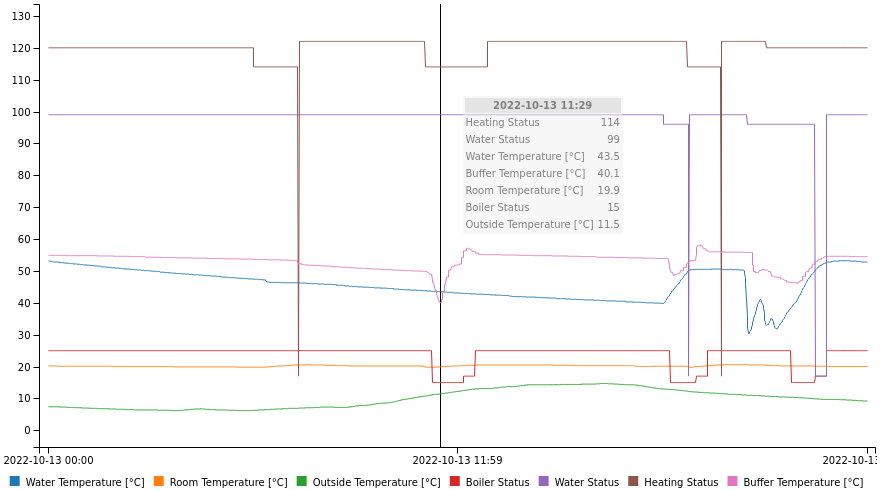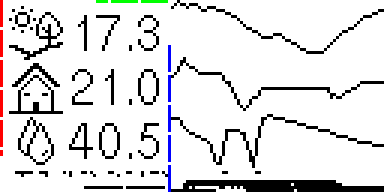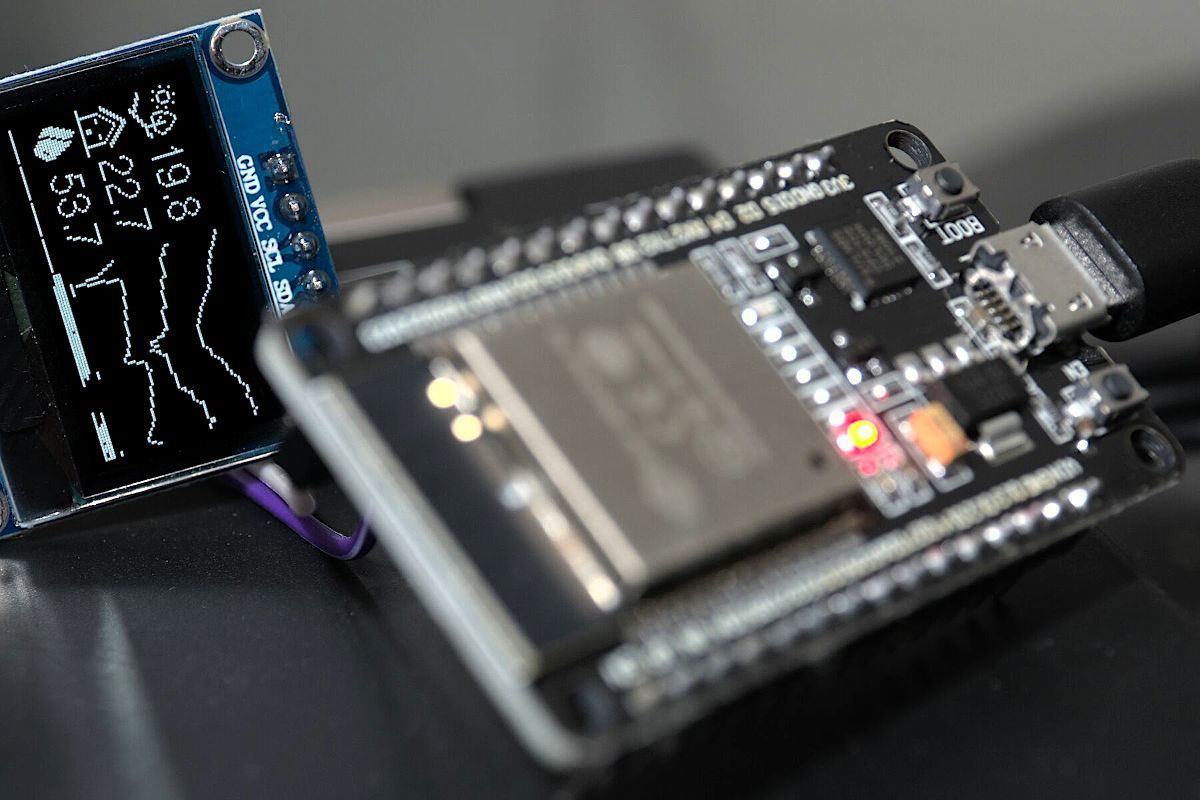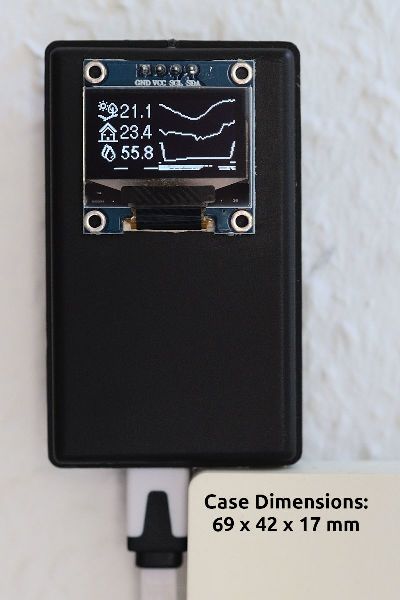BSB-LAN monitor by user -cr
Monitoring some heating related parameters via BSB-LAN,
using an esp32 board (optionally) fitted with an ssd1306 display.
Inspired by (https://forum.fhem.de/index.php/topic,110599.0.html).

Introduced with v0.7.0
This requires BSB-LAN source code from 2022-08-20 or newer!
Enable UDP logging in BSB-LAN's configuration (URL command /C),
with a log interval of ten seconds (recommended; other values up to about 55s should
also work without loss of functionality) and the log parameters used
in BSBmonCR's config.h (c.f. below).
Put the files from the BSB-LAN sub-directory into your BSB-LAN sketch directory
and don't forget to put #define CUSTOM_COMMANDS into BSB_LAN_config.h.
Adjust BSBmonCR_config.h contents,
then (re-) compile BSB-LAN.ino and install it on the unit attached to your BSB.
(I've been using BSB-LAN versions since 2.1.3-20220209235153 with BSBmonCR, btw.)
Copy config.h.default to config.h and edit config.h according to your needs:
- WiFi credentials must be adjusted here;
- BSB parameters may also need adjusting;
- for server variant 2
#define UDP_PORT 28000; - everything else is optional.
Then compile
BSBmonCR.inoand install it on your esp32 to be used as a monitor.
If all goes well, you should see data from your BSB-LAN system displayed on the BSBmonCR unit.
(For examples, see below.)
Outside, room and water temperature (current value and preceding 24 h plot) are displayed. There's also a thin line below the temperature plots, showing when the boiler was active. The house/water symbol is filled when the house/water is being heated (half filled when the boiler is not running, e.g. because the boiler is in overrun or a buffer is used).
Upon power-up, the monitor will display placeholder values for the temperatures, which should within seconds be replaced by values from your BSB-LAN unit.
The plots on the right will take at least 20 minutes to begin to show, longer when the average temperature in the first 20 minutes is the same as in the currently running 20 minutes. Vertically, the plots scale automatically to fully use the limited space available. They will look best once the first 24 hours have elapsed and the plots take up their whole width.
Introduced with v0.3.0 (first version on GitHub)
You can add a presence check for computer systems (e.g. cell phones, which
roughly translates to people) in your network. Note that for simplicity
reasons this has been implemented using ping, which is not the most
reliable method. If you are willing to sacrifice some display space for
this feature, #define ADDR_TO_CHECK in config.h.
If activated, each of the systems monitored will take up a single pixel row at the bottom of the screen, plus 0-2 empty lines above them (none for the number of monitored systems being multiples of three (3/6/...), one empty line for 2/5/8/... systems, two for 1/4/7/...).
Introduced with v0.5.0
With #define WITH_NERDY_TIMESTAMP_DISPLAY in config.h, a binary
encoding of the current date and time will be displayed to the left
of the boiler status line. Note that this display will only be
updated when BSBmonCR either receives data via UDP, updates one of
the presence indicators (if configured), or advances the rolling
plots.
Use perl Decode_nerdy_timestamp_in_BSBmonCR_screenshot.pl
(from the tools directory) to
decode the timestamp in bitmaps received from BSBmonCR, either
providing a bitmap file name as an argument to this script,
or feeding it such content directly, e.g. by prepending the following
to the command above: wget -qO- BSBmonCR | (i.e. if BSBmonCR is the
name of your BSBmonCR system in your network; replace with the right
name or IP address, if necessary).
Introduced with v0.8.0
With a heating buffer configured, its temperature values are included in logging (if enabled), and a vertical line is placed to the left of the 24 hours plots. Its height shows the current buffer temperature relative to its minimal and maximal values within the most recent 24 hours (e.g. 50 percent height = halfway between min and max).
Introduced with v0.8.3
As an alternative to the relative scaling described above, a fixed
scale can also be selected for the buffer temperature in config.h.
Introduced with v0.9.0
If you have a small solar energy system registered with nepviewer.com
you can also have its most1 recent power report displayed by setting
PV_IDENT in config.h.
That value will then be displayed as a vertical line to the very left
of the screen, scaled for 10 Watts per pixel, in bars of 10 pixels, i.e.
100 Watts for each full bar. (If your solar system does more than 600
Watts, you may want to adjust the scaling in BSBmonCR.ino.)
Introduced with v0.9.3
Additionally, the current day's energy generation will be
displayed as a horizontal bar in the top line, scaled for 100 Wh
per pixel, in bars of 10 pixels, i.e. 1 kWh for each full bar.
(Again, depending on your solar system's capacity, you may want to
adjust the scaling in BSBmonCR.ino.)
Introduced with v0.2.0
You should also be able to display BSBmonCR screen contents
(even without an ssd1306 display attached) on any web browser in your network
by loading http://<your-BSBmonCR-address>/
Introduced with v0.4.0
Periodic saving of both screenshots and log files
to a Dropbox account can be enabled in config.h. For this function to work,
read/write access permission must be granted to BSBmonCR; to achieve
this, load Get_Dropbox_token_for_BSBmonCR.html (from the tools
directory) in your web browser and follow the instructions.
The files saved will be named yyyy-mm-dd.*, with the files' basename
representing the current day. They will be updated as specified in
config.h. Screenshots are saved in Windows bitmap format (*.bmp),
data logs as comma separated value text files (*.csv) with a single
line for each minute, giving the timestamp (hh:mm) and the values for
the logged parameters at that time. The values are logged as
received via UDP, i.e. temperatures are multiplied by ten
(e.g. 20.1 °C will be logged as 201). For simplicity reasons,
the CSV files will not contain a heading for the column names.
To limit log data loss when restarting your BSBmonCR unit,
existing *.csv files will be read and continued when switching
to a new yyyy-mm-dd. Performing an OTA Update will
force *.csv writing immediately before the device's reset and reload
the data from the file and continue it after the reset.
BSBmonCR's *.csv files can be plotted using BSBmonCR_log_viewer.html
(from the tools directory),
which provides exact readings of a sample set's values (by hovering
over the plot), zoom (mouse wheel / pinch) and scroll (drag)
functionality as well as data line highlighting / disabling (hover
over / (alt-) click on line enty in legend).
Should you wish to view multiple log files combined, create a compiled
file by concatenating the original files, with each line prefixed with
the orignal file's basename and a space. One way to do this is by using
the following command:
perl -pe '($x=$ARGV)=~s/\..+/ /;s/^/$x/' ????-??-??.csv >combined.csv2
As these combined files may overload BSBmonCR_log_viewer.html (especially
with a complete month's data or even more), you may want to create
reduced versions for display, e.g. by removing all but the
minute-is-divisible-by-ten data lines through processing the files with
perl -ne 'print if /:.0,/'.3
You can calculate the hours your burner was active by using the following
command on BSBmonCR's *.csv log files:
perl -ne '$n++if(split/,/)[3]<17;END{printf"%.0f h\n",$n/60}' *.csv
If you know how much fuel your burner uses per hour (its rated power [kW] combined with your fuel's fuel value [kW/kg] should give you a starting point), you can use that to transform hours of burner activity into fuel consumed.
Introduced with v0.6.0
By loading http://<your-BSBmonCR-address>:8080/ in your web browser,
you can update your BSBmonCR's software "over the air" (OTA).
There you can upload a file created via Sketch -> Export compiled binary file...
in the Arduino IDE. (Of course this works only with an esp32 already
running OTA enabled software, i.e. the first time you have to load the
BSBmonCR software onto your esp32 via USB.)
Introduced with v0.10.0
Requires a buffer in your heating system!
If you want to limit boiler starts for DHW to once a day, you can set
LIMIT_BOILER_RUNS_FOR_WATER in config.h and adjust the values following
that #define to match your heating system's settings.
Instead of another boiler run for DHW, the water will only be heated as far as the buffer allows, then DHW will be disabled for the day (or until heating water from the buffer would be feasible again).
If required, a manual DHW push will always be possible, though. When the boiler is running to heat the house anyway, DHW heating will also be done.
Introduced with v0.10.6: By defining NO_BOILER_STARTS_FOR_WATER_AFTER_INITIAL_RUN in config.h, the boiler will not start for DHW if it has already run that day.
Animated (and obviously sped up) display progress in full featured (minus solar power display) configuration:
Example data log (see above for information on how to create these):
Status values are given as provided by BSB-LAN.4
Corresponding BSBmonCR screen contents (enlarged and color coded for explanation / correlation to log view above):
The screen example shows presence indication for four cell phones configured (bottom four "pixel" lines), as well as timestamp encoding enabled (light blue bit pattern5).
Enlarged and color coded (for explanation) example with fixed scale for the (optional) buffer temperature (blue, 10 °C to each full vertical bar, 49 °C here) and (also optional) solar power display (most recent power reading in red, 100 W to each full vertical bar, 520 W here, and current day's energy total in green, 1 kWh to each full horizontal bar, 2.4 kWh here):
Naked esp32 fitted with ssd1306 display:
Wall mounted BSBmonCR system (I'm lacking the tools to fit the display in the case):
- In most places, screen coordinates are hard coded for a 128*64 display, not calculated to fit a screen with possibly differing dimensions.
- Error handling in some cases may not be considered "production ready".
- Coding style is not always consistent (e.g. usage of
Stringvs.char*). - In serving screenshots, HTTP handling is pragmatic, not polite.
- Code comments are limited to what I personally have found useful (e.g. no comment blocks introducing functions, ...).
- Presence indication via ping is not always reliable (e.g. some cell phones' power saving functions may interfere).
- Depending on your solar power system's connectivity, nepviewer.com may not always have recent values that can be displayed.
- When the buffer temperature drops really fast, limiting boiler runs for DHW may not react quickly enough to avoid boiler startup.
Footnotes
-
It's actually fairly recent, depending on
PV_UPDATE_INTERVALinBSBmonCR.ino. ↩ -
That is, if you're on Unix. For Windows, use
perl -pe "BEGIN{@ARGV=map{glob}@ARGV}($x=$ARGV)=~s/\..+/ /;s/^/$x/" ????-??-??.csv >combined.csvinstead to expand the?wildcards. Perl is free software, btw. :) ↩ -
On Windows, use double quotes instead of single quotes. ↩
-
For an explanation of the status values, use
http://bsb-lan/E8001etc. (replacebsb-lanwith your BSB-LAN system's network address). ↩ -
-----XXX XXX--XX-= 2022,----X-X-= 10,----XX-X= 13,--------= 0,--------= 0,----X--X= 9 (with a line below to mark the LSB (least significant bit) of each byte -> 2022-10-13T00:00:09 :) P.S. The coding has changed slightly with v0.10.10: now the century is encoded separately from the rest of the year, i.e. 2022 would be encoded as ---X-X-- ---X-XX-. ↩





